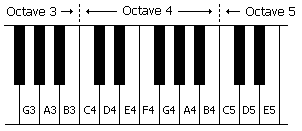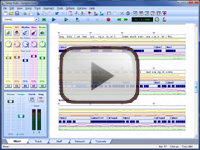(1.8) The Octave of a Note
You might be wondering how to refer to a particular A note, now that we know there are several of them.
The easy answer is that it often doesn't matter. Since notes an octave apart sound similar, a tune played one octave up or down will still sound the same as the original, just higher or lower.

If the exact octave is important, you can relate it to Middle C, which has a frequency of 261.63 Hz. For example, you could refer to 'A above Middle C' as we did earlier.
The 'middle' in Middle C comes from it being the C note in the centre of the piano keyboard. It is also the note in between the bass and treble staff lines in standard musical notation (more on this later).

Writing notes on staff lines pinpoints them in a specific octave. Each of the staff lines, and the spaces in between them, represent a note relative to Middle C.
Another convention, often used with computer music, is to follow the note with an octave number. For example, Middle C might be labelled C4, while C5 would be the C note one octave up from it.
These numbers are not standardised, so you will need to make it clear which octave number you are using for Middle C. Also, within an octave the notes should be arranged from C to B and not (as you might expect) from A to G.












